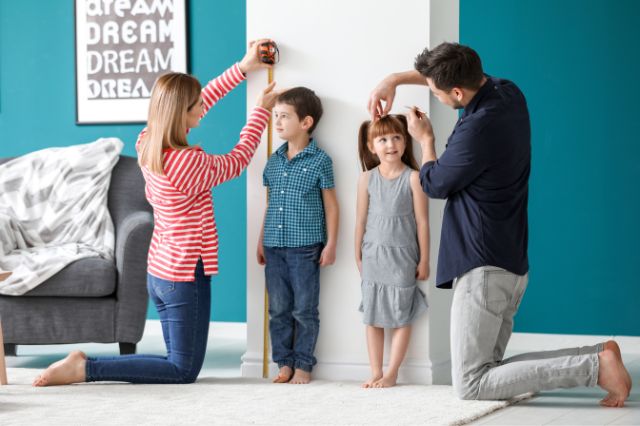Understanding dimensions is a crucial step in a child’s mathematical journey. In this comprehensive guide, we will delve into the basics of length, width, and height, providing practical tips and engaging activities to make learning an enjoyable adventure for young minds.
The Basics of Length, Width, and Height
Length, width, and height are fundamental dimensions that surround us daily. These concepts form the building blocks of measurement, helping children make sense of the world around them. By introducing these terms in a way that relates to their everyday experiences, parents can make the learning process more accessible and enjoyable for their kids.
Grasping Length Concepts
Length, the measurement from one end to another, can be a challenging concept for young learners. To make this concept tangible, parents can engage their children in hands-on activities using familiar objects. Encourage your child to measure items like pencils or books, comparing their lengths. This not only reinforces the concept of length but also introduces the idea of comparison and relative sizes.
- Tip: Use everyday scenarios to explain length, such as comparing the length of a table to a bed.
- Fun Fact: The length of a standard school bus is approximately 45 feet! You can measure this out with your child to visualize the concept.
Width Made Simple
Width, the measurement from side to side, is another dimension that can be made simple and engaging for kids. Parents can involve their children in exploring the width of common items found in their environment. Whether it’s measuring the width of a classroom desk or a piece of paper, these activities provide practical examples that connect mathematical concepts to the real world.
- Tip: Incorporate width into daily routines, like measuring the width of a doorway or a piece of furniture.
- Fun Fact: The width of a typical car is around 6 feet. You can measure your car or compare it to other objects to make the concept more relatable.
Height in Kid-Friendly Terms
Understanding height, the measurement from the base to the top, can be made more accessible for kids by incorporating relatable examples. Parents can make the learning experience enjoyable by measuring the height of family members and creating a visual chart. This not only teaches the concept of height but also allows children to see the variation in heights within their own family.
- Tip: Use everyday objects to demonstrate height, such as comparing the height of a chair to a table.
- Fun Fact: The height of the world’s tallest building, the Burj Khalifa, is approximately 828 meters! While this may be an extreme example, it emphasizes the vast range of heights in the world.
Applying Dimensions in Everyday Life
Showcasing the practical applications of dimensions makes the learning experience more meaningful for kids. Parents can involve their children in everyday activities that require measurement, such as baking or crafting. By integrating dimension concepts into these activities, children can see the relevance of what they’re learning.
- Tip: Involve your child in cooking and baking, where precise measurements are crucial for a successful outcome.
- Fun Fact: Tailors use length, width, and height to create perfectly fitting clothes. This connects the concept of dimensions to real-world professions.
Customizing Education for Every Child
Recognizing diverse learning styles is key to effective dimension education. Parents can identify whether their child learns best through visuals, hands-on activities, or discussions. By customizing the learning experience to suit individual preferences, parents can enhance their child’s understanding and retention of dimension concepts.
- Tip: Observe how your child responds to different teaching methods and adapt accordingly.
- Fun Fact: Different cultures have unique measurement units, showcasing the diversity in dimension understanding. Discussing these differences can make the learning experience more culturally enriching.
Preparing Kids for Advanced Math
Linking dimension understanding to advanced mathematical concepts lays the groundwork for future learning. Parents can explore geometric shapes and their dimensions with their children, connecting theory to real-world examples. This not only reinforces basic dimension concepts but also sparks curiosity about more complex mathematical ideas.
- Tip: Introduce your child to geometric shapes and explore their dimensions through simple drawings and hands-on activities.
- Fun Fact: Architects use precise measurements to design buildings with optimal proportions. This highlights the practical applications of dimensions in professional fields.
Length Explained in Simple Terms
Demystifying length for kids involves breaking down the concept into easily digestible parts.
Demystifying Length for Kids
Length, while a fundamental dimension, can be a challenging concept for young minds. Parents can demystify length by using relatable examples such as the length of a favorite toy or the distance from home to school. Connecting abstract measurements to the familiar surroundings of a child makes the concept more accessible.
- Tip: Relate length to personal experiences, like measuring the length of a favorite toy or comparing the lengths of different objects.
- Fun Fact: The length of a soccer field is standardized at approximately 100 yards. This can be a fun fact to share while engaging in activities related to sports and recreation.
Incorporating Play into Mathematical Education
Make math enjoyable by incorporating play into the learning process. Parents can use games like “Measure the Room,” where kids measure various objects with a tape measure. This not only makes learning fun but also reinforces the practical application of mathematical concepts.
- Tip: Create games that involve measuring objects around the house or in the yard, turning learning into a playful activity.
- Fun Fact: Board games often involve dimensions, subtly reinforcing mathematical concepts. Playing these games as a family can make math a positive and shared experience.
Measurement Adventures for Kids
Embarking on measurement adventures turns learning into an exciting journey.
Taking Kids on a Dimensional Journey
Parents can turn dimension learning into an adventure by planning outdoor scavenger hunts. In these hunts, kids can measure nature’s elements like leaves or rocks, connecting the abstract concept of measurement to tangible experiences in the natural world.
- Tip: Plan outdoor activities where children can explore and measure different elements of nature, turning learning into an adventure.
- Fun Fact: Explorers use GPS technology, relying on length, width, height coordinates for accurate navigation. This fact ties measurement to real-world exploration.
Supporting Your Child’s Mathematical Journey
Parents play a crucial role in supporting a child’s mathematical development. Encouraging questions and exploration fosters a positive attitude towards learning. By creating an environment where math is not intimidating but rather an exciting journey, parents can nurture their child’s mathematical curiosity.
- Tip: Create a supportive atmosphere where questions are encouraged, and mistakes are viewed as opportunities to learn.
- Fun Fact: Many successful scientists and engineers were once kids fascinated by the dimensions of the world. This fact can inspire children to see the real-world impact of mathematical knowledge.
Conclusion
In conclusion, teaching kids about length, width, and height involves creativity, engagement, and real-world applications. By making math help for kids enjoyable and tailored to individual learning styles, we set the stage for a lifelong appreciation of mathematical concepts. Length explained, width made simple, and height in kid-friendly terms become building blocks for a future where math is not just a subject but an exciting adventure.













